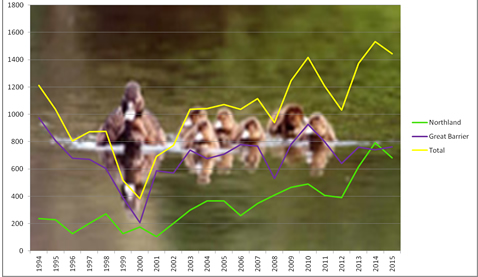Brown Teal (Pateke)
Naumai haere mai, welcome to our site about New Zealand’s Brown Teal (Pakete), efforts to help conserve and manage them, and who is involved. The information and work programs covered in this site are part of DOC – Pateke Recovery Program efforts and long-term commitment to conserve this unique species as part of our natural heritage.
The Brown Teal (Anas chlorotis), or pateke, is a small dabbling duck species endemic to New Zealand historically distributed throughout the lowland freshwater wetlands.
The brown teal’s omnivorous diet, restricted annual range and mainly terrestrial lifestyle give it a unique ecological niche among waterfowl, somewhat akin to a wetland rodent, and it serves as a classic example of the influence of selective forces that operated on birds in pre-human New Zealand.
The Brown Teal (pateke) was once widespread throughout New Zealand but is now rare and restricted to Great Barrier Island and coastal valleys of eastern Northland and selected reintroduction sites.
The species has suffered an ongoing decline in numbers and range since the late nineteenth century.
There are currently between 2500 – 3000 brown teal living in a wild state in New Zealand, making it New Zealand’s rarest waterfowl species on the mainland.
The International Union for Conservation of Nature and Natural Resources (IUCN) conservation criteria (IUCN, 1994) list brown teal as “endangered”, and the New Zealand Department of Conservation (DOC) lists it as a “Recovering” species.
The Department of Conservation’s Brown Teal (Pakete) Recovery Plan in 2000 predicted the imminent extinction of the Brown Teal in Northland, and forecasts only medium term brown teal survival on Great Barrier Island without intervention.
Luckily in 2022 the future for Pateke looks a lot brighter, after some serious effort to halt the decline at the remaining wild sites in Northland and Great Barrier Island, those populations are now considered stable. With the addition of a captive to wild reintroduction’s, we have now seen the successful re-establishment of a further 7 self sustaining populations with other sites in progress.
Responsible for the decline are the traditional factors that have had major impacts on all native New Zealand bird life since the arrival of humans. Primarily predation from introduced mammals i.e Stoats, Feral Cats, Ferrets etc along with habitat loss through wetland drainage and estuary reclamation.
If you would like to help promote the endangered New Zealand Brown Teal
please feel free to link to us or place our banner on your website.
If you would like to sponsor or promote Brown Teal as part of
your business please contact us today.



